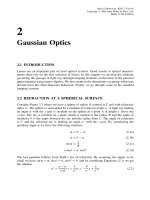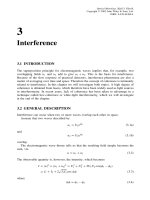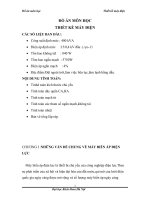Tài liệu Đo lường quang học P8 doc
Bạn đang xem bản rút gọn của tài liệu. Xem và tải ngay bản đầy đủ của tài liệu tại đây (573.51 KB, 24 trang )
8
Speckle Methods
8.1 INTRODUCTION
When looking at the laser light scattered from a rough surface, one sees a granular
pattern as in Figure 8.2. This so-called speckle pattern can be regarded as a multiple wave
interference pattern with random individual phases. In the years following the advent of
the laser, this pattern was considered a mere nuisance, especially in holography (and it
still is!). But from the beginning of 1970 there were several reports from experiments in
which speckle was exploited as a measuring tool. In this chapter the basic principles of
the different techniques of speckle metrology will be described. As a spin-off from laser
speckle, methods based on similar principles using incoherent light have emerged. This
white-light speckle photography is included in the final section of the chapter.
8.2 THE SPECKLE EFFECT
In Figure 8.1, light is incident on, and scattered from, a rough surface of height variations
greater than the wavelength λ of the light. As is shown in the figure, light is scattered
in all directions. These scattered waves interfere and form an interference pattern con-
sisting of dark and bright spots or speckles which are randomly distributed in space. In
white light illumination, this effect is scarcely observable owing to lack of spatial and
temporal coherence (see Section 3.3). Applying laser light, however, gives the scattered
light a characteristic granular appearance as shown in the image of a speckle pattern in
Figure 8.2.
It is easily realized that the light field at a specific point in a speckle pattern must be
the sum of a large number N of components representing the light from all points on the
scattering surface. The complex amplitude at point in a speckle pattern can therefore be
written as
u =
1
√
N
N
k=1
u
k
=
1
√
N
N
k=1
U
k
e
iφ
k
(8.1)
By assuming that (1) the amplitude and phase of each component are statistically inde-
pendent and also independent of the amplitudes and phases of all other components, and
(2) the phases φ
k
are uniformly distributed over all values between −π and +π, Goodman
(1975) has shown that the complex amplitude u will obey Gaussian statistics. Further he
Optical Metrology. Kjell J. G
˚
asvik
Copyright
2002 John Wiley & Sons, Ltd.
ISBN: 0-470-84300-4
194
SPECKLE METHODS
l
Figure 8.1 Light scattering from a rough surface
Figure 8.2 Photograph of a speckle pattern
1.0
0
0.5
24
I
〈
l
〉
〈
l
〉
P
I
(
l
)
Figure 8.3
has shown that the probability density function P
I
for the intensity in a speckle pattern
is given as
P
I
(I ) =
1
I
exp
−
I
I
(8.2)
where I is the mean intensity. The intensity of a speckle pattern thus obeys negative
exponential statistics. Figure 8.3 shows a plot of P
I
(I ). From this plot we see that the
most probable intensity value is zero, that is, black.
SPECKLE SIZE
195
A measure of the contrast in a speckle pattern is the ratio C = σ
I
/I,whereσ
1
is the
standard deviation of the intensity given by
σ
2
1
=I
2
=(I −I)
2
=I
2
− 2II +I
2
=I
2
−I
2
(8.3)
where the brackets denote mean values. By using
I
2
=
∞
0
P
I
(I )I
2
dI = 2I
2
(8.4)
we find the contrast C in a speckle pattern to be unity.
8.3 SPECKLE SIZE
From Figure 8.2 we see that the size of the bright and dark spots varies. To find a
representative value of the speckle size, consider Figure 8.4, where a rough surface is
illuminated by laser light over an area of cross-section D. The resulting so-called objective
speckle pattern is observed on a screen S at a distance z from the scattering surface. For
simplicity, we consider only the y-dependence of the intensity. An arbitrary point P on
the screen will receive light contributions from all points on the scattering surface. Let us
assume that the speckle pattern at P is a superposition of the fringe patterns formed by
light scattered from all point pairs on the surface. Any two points separated by a distance l
will give rise to fringes of frequency f = l/(λz) (see Section 3.6.1, Equation (3.35)). The
fringes of highest spatial frequency f
max
will be formed by the two edge points, for which
f
max
=
D
λz
(8.5)
The period of this pattern is a measure of the smallest objective speckle size σ
o
which
therefore is
σ
o
=
λz
D
(8.6)
For smaller separations l, there will be a large number of point pairs giving rise to fringes
of the corresponding frequency. The number of point pairs separated by l is proportional
z
P
S
D
Figure 8.4 Objective speckle formation
196
SPECKLE METHODS
to (D − l). Since the various fringe patterns have random individual phases they will add
incoherently. The contribution of each frequency to the total intensity will therefore be
proportional to the corresponding number of pairs of scattering points. Since this number
is proportional to (D − l), which in turn is proportional to (f
max
− f), the relative number
of fringes versus frequency, i.e. the spatial frequency spectrum will be linear, as shown
in Figure 8.5.
Figure 8.6 shows the same situation as in Figure 8.4 except that the scattering sur-
face now is imaged on to a screen by means of a lens L. The calculation of the
size of the resulting so-called subjective speckles is analogous to the calculation of
the objective speckle size. Here the cross-section of the illuminated area has to be
exchanged by the diameter of the imaging lens. The subjective speckle size σ
s
therefore
is given as
σ
s
=
λb
D
(8.7)
where b is the image distance. By introducing the aperture number
F =
f
D
(8.8)
0
f
max
f
Relative number of fringes
Figure 8.5
a
b
L
Figure 8.6 Subjective speckle formation
SPECKLE PHOTOGRAPHY
197
where f is the focal length, we get
σ
s
= (1 + m)λF (8.9)
where m = (b − f)/f is the magnification of the imaging system. From this equation we
see that the speckle size increases with decreasing aperture (increasing aperture number).
This can be easily verified by stopping down the eye aperture when looking at a speckle
pattern.
Speckle formation in imaging cannot be explained by means of geometrical optics
which predicts that a point in the object is imaged to a point in the image. The field at a
point in the image plane therefore should receive contributions only from the conjugate
object point, thus preventing the interference with light from other points on the object
surface. However, even an ideal lens will not image a point into a point but merely form a
intensity distribution (the Airy disc, see Section 4.6) around the geometrical image point
due to diffraction of the lens aperture. This is indicated in Figure 8.6. It is therefore
possible for contributions from various points on the object to interfere so as to form a
speckle pattern in the image plane.
8.4 SPECKLE PHOTOGRAPHY
Discussions on the subject of speckle photography can be found, for example, in Burch
and Tokarski (1968), Dainty (1975), Erf (1978), Fourney (1978), Hung (1978) and Jones
and Wykes (1989).
8.4.1 The Fourier Fringe Method
Assume that we image a speckle pattern onto a photographic film. After development
this negative is placed in the object plane of a set-up for optical filtering like that in
Figure 4.12. Figure 8.7 shows (Fourney 1978)
(1) a speckle pattern on the negative;
(2) the resulting diffraction pattern (the spatial frequency spectrum) in the x
f
, y
f
-plane; and
(3) typical form of the smoothed intensity distribution along the x
f
-axis.
The dark spot in the middle of Figure 8.7(b) is due to the blocking of the strong zeroth-
order component. Figure 8.7(c) displays the essential feature discussed in Section 8.2,
namely that the imaged speckle pattern contains a continuum of spatial frequencies
ranging from zero to f
max
=±1/σ
s
,whereσ
s
is the smallest speckle size given from
Equation (8.7). For a circular aperture the frequency distribution will not be exactly linear
as in Figure 8.5, but merely as indicated in Figure 8.7(c).
Now assume that we in the diffraction plane (the filter plane) place a screen with a
hole a distance x
f
from the optical axis. This situation is illustrated in Figure 8.8, where
Figure 8.8(a, b) shows the spectra before and after the filtering process has taken place.
The same spectrum (as in Figure 8.8(b)) would have resulted by filtering out the first side
198
SPECKLE METHODS
(a)
(b)
(c)
−l
0
f
/s
s
l
0
f
/s
s
x
f
I
(
x
f
)
x
f
Figure 8.7 (a) Speckle pattern and its corresponding; (b) diffraction pattern; and (c) intensity dis-
tribution along the x
1
-axis. ((a) and (b) reproduced from Fourney (1978) by permission of Academic
Press, New York.)
x
f
x
f
x
f
x
f
I
(
x
f
)
(b)
(a)
Figure 8.8 Spectrum of a speckle pattern (a) before and (b) after filtering
SPECKLE PHOTOGRAPHY
199
order from a sinusoidal grating of frequency
f
x
=
x
f
λ
0
f
(8.10)
where f is the focal length of the transforming lens and λ
0
is the wavelength of the
light source applied in the filtering process. What we have actually done therefore is to
select one of the numerous gratings with a continuum of directions and frequencies that
constitute the laser-illuminated object.
As a consequence, we can imagine that a grating given by
t
1
= a(1 + cos 2πf
x
x) (8.11)
is attached to the object surface. When the object undergoes an in-plane deformation,
the speckle pattern will follow the displacements of the points on the object surface.
Consequently, the grating will be phase-modulated and thus can be written as
t
2
= a[1 + cos 2π(f
x
x + ψ
x
(x))] (8.12)
This is closely analogous to the situation described in Section 7.4 where a model grating
was attached to the object for measurement of an in-plane deformation by means of moir
´
e
technique. In the same way as described there, we can image the speckle pattern before
and after the deformation onto the same film negative by double exposure. The resulting
transmittance then becomes equal to t
1
+ t
2
, the sum of Equations (8.11) and (8.12). The
two speckle patterns could possibly also be imaged onto two separate negatives and
subsequently superposed, giving a resultant transmittance equal to t
1
· t
2
, but this is more
difficult to achieve. By means of optical filtering of the double-exposed negative we
get an intensity distribution dependent on the modulation function only (see Section 4.7,
Equation (4.66)). This distribution will be maximum for ψ
x
(x) = n and minimum for
ψ
x
(x) = n + (1/2) and correspond to displacements (cf. Equations (7.10) and (7.13))
equal to
u(x) = n
1
f
x
= n
λ
0
f
x
f
for maxima (8.13a)
u(x) =
n +
1
2
λ
0
f
x
f
for minima (8.13b)
in direct analogy with the moir
´
e method. In deriving Equation (8.13) we have assumed
unit magnification. These values therefore must be divided by the magnification m applied
when recording the speckle patterns.
The speckle pattern represents gratings of all orientations in the plane of the object (cf.
the spectrum in Figure 8.7(b)). Therefore, by placing the hole in the screen in the filter
plane a distance y
f
along the y
f
-axis we obtain the modulation function ψ
y
(y) and the
corresponding displacement v
y
(y) along the y-axis. Generally, by placing the hole in the
filter plane at a point of coordinates x
f
, y
f
, the resulting intensity distribution will give a
displacement equal to
s(x, y) =
u
2
(x) + v
2
(y) = nλ
0
f
(1/x
f
)
2
+ (1/y
f
)
2
for maxima (8.14a)
200
SPECKLE METHODS
s(x, y) = (n +
1
2
)λ
0
f
(1/x
f
)
2
+ (1/y
f
)
2
for minima (8.14b)
In this case we thus measure the displacement along a direction inclined an angle β to
the x-axis given by
tan β = y
f
/x
f
(8.15)
In this method we can therefore vary the measuring sensitivity by varying x
f
and y
f
,and
a remarkable property of this technique is that the sensitivity can be varied subsequent
to the actual measurement, that is, after the speckle patterns have been recorded. Highest
sensitivity is obtained by placing the filtering hole at the edge of the spectrum. The
first-order dark fringe then corresponds to a displacement equal to
s
min
=
1
2
σ
s
=
1
2
λb
D
= 0.5(1 + m)λF (8.16)
With a magnification m = 1, this gives a sensitivity equal to the laser wavelength mul-
tiplied by the aperture number of the imaging lens. The sensitivity limit by using laser
speckle photography can therefore be down to about 1 µm.
Figure 8.9 shows an example of such Fourier fringes obtained by this method (Hung
1978). Note that as the filtering hole is moved away from the optical axis, the number of
fringes increases, i.e. the sensitivity is increased.
Figure 8.9 Fringe patterns depicting the horizontal and vertical displacements of a cantilever
beam obtained from the various filtering positions in the Fourier filtering plane. (Reproduced from
Hung 1978 by permission of Academic Press, New York.)
SPECKLE PHOTOGRAPHY
201
8.4.2 The Young Fringe Method
On photographing a speckle pattern, each speckle will form a pointlike blackening on the
film. When the object undergoes an in-plane deformation, the speckle pattern will follow
this deformation. A double-exposed negative of two speckle patterns resulting from a
deformation therefore will consist of identical point pairs separated by a distance equal
to the deformation times the magnification of the imaging system.
Assume that we illuminate this double-exposed negative with an unexpanded laser
beam. When the beam covers one pair of identical points, they will act in the same way
as the two holes P
1
and P
2
in the screen of the Young’s interferometer (see Figure 3.13,
Section 3.6.1). On a screen at a distance z from the negative we therefore will observe
interference fringes which are parallel and equidistant and with a direction perpendicular
to the line joining P
1
and P
2
, i.e. perpendicular to the displacement.
The situation is sketched in Figure 8.10. In Section 3.6.1 we found that the distance
between two adjacent fringes in this pattern is equal to
d =
λz
D
(8.17)
where D is the distance between P
1
and P
2
. If the displacement on the object is equal
to s the separation of the corresponding speckle points on the negative is equal to m · s
where m is the magnification of the camera. Put into Equation (8.17) this gives, for the
object deformation,
s =
λz
md
(8.18)
In deriving the equations for the Young fringe pattern in Section 3.6.1 we used the approx-
imation sin θ = tan θ. Without this approximation Equation (8.18) becomes
s =
λ
m sin θ
(8.19)
By measuring the fringe separation d we can therefore find the object displacement at the
point of the laser beam incidence using Equation (8.18). Better accuracy is obtained by
measuring the distance d
n
covered by n fringes on the screen. We then have d = d
n
/n,
z
d
Negative
Laser
Screen
Figure 8.10 Young fringe formation









